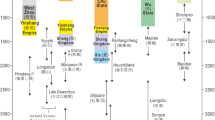Abstract
China is one of the ancient civilization countries. Owing to the blind reclamation, the vegetation had been destroyed, causing soil erosion and desertification, and making the civilization center move to the Changjiang (Yangtze) River valley from the Huanghe (Yellow) River. This movement began in the Qin and Han dynasties (221 B.C.-220 A.D.) because at that time the large-scale reclamation was felled, the grassland was reclaimed into farmland, the vegetation was seriously destroyed in the loess and north of the Huanghe River, and the climate was getting colder; and the turn from north to south occurred in the Sui and Tang dynasties (581–907 A.D.) and completed in the Song Dynasty (960–1279 A.D.). However, at present the vegetation damage of the Changjiang River valley is very serious too and the silt carrying capacity of the Changjiang River is increasing sharply; thus the Changjiang River is in danger of becoming a second Huanghe River, so we must pay attention to the protection of ecological environment.
Similar content being viewed by others
References
宁可.历史研究.1986, (6): 3–20.
陈 正祥. 中国文化地理. 北京: 三联书店, 1983. 135–186.
中国科学院«中国自然地理»编辑委员会. 中国自然地理 (历史自然地理). 北京: 科学出版社, 北京, 1982. 33–86.
余 文涛, 袁 清林, 毛 文永. 中国环境保护. 北京: 科学出版社, 1987. 105–113.
Author information
Authors and Affiliations
Rights and permissions
About this article
Cite this article
Kong, F. The destruction of ancient ecological environment and the movement of civilization center in China. Chinese Geographical Science 2, 382–388 (1992). https://doi.org/10.1007/BF02664569
Issue Date:
DOI: https://doi.org/10.1007/BF02664569




